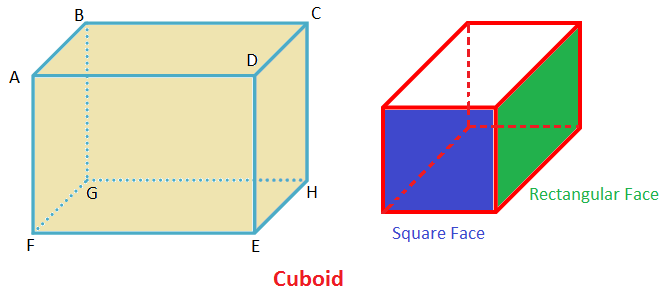A convex polyhedron that is bound by exactly six quadrilateral faces is called a cuboid. This quadrilateral is usually in the form of a rectangle, and the polyhedral graph is the same as a cube.
Contents
How to Find the Surface Area and Volume of a Cuboid?
When we talk of this shape, the first computations performed are how to find the volume and surface area of cuboid. Such a cuboid is also called rectangular cuboid, right cuboid, rectangular hexahedron, rectangular parallelepiped, rectangular box or right rectangular prism.
According to Euler’s formula, the number of edges, vertices, and faces is related by the given formula, Faces + Vertices = Edges + 2. For a cuboid, we have 12 edges, 8 vertices, and 6 faces. Hence, this formula is satisfied as, 6 + 8 = 12 + 2.
Surface Area
When discussing the surface area associated with any shape, we have to take into account two types as follows:
- Curved Surface Area or Lateral Surface Area (LSA).
- Total Surface Area (TSA).
Lateral Surface Area of a Cuboid
CSA is usually used with shapes that have a curved surface, such as a cone or cylinder. However, in the case of shapes such as cuboids where there is no curved surface, we find the lateral surface area. LSA can be defined as the area occupied by the sides of a figure, excluding the top and bottom. Thus, for a cuboid, if the length is denoted by l, breadth is b, and height is h, then the formula for the LSA is written as follows:
LSA of a cuboid = sum of the area of the 4 rectangular sides
LSA of a cuboid = (l * h) + (l * h) + (b * h) + (b * h) = 2 (l * h) + 2 (b * h) = 2 h (l + b)
Total Surface Area of Cuboid
This denotes the complete area occupied by the cuboid. We also include the base and top to get the TSA or in other words, it is the area of all 6 sides. Thus, we can also say that TSA is the sum of LSA, the top and the base. The formula for TSA of a cuboid is given below:
TSA of a cuboid = Area of all 6 rectangular sides:
= LSA + base + top = 2 h (l + b) + (l * b) + (l * b) = 2 (lh + bh + bl)
Volume of a Cuboid
The volume of the cuboid is defined as the space contained within the walls of the three-dimensional figure or the capacity. The volume of cuboid formula can be written as
Volume of a cuboid = l * b * h
Diagonal of the Cuboid
In the case of a cuboid, the formula for the diagonal is given as:
Length of a diagonal = √l2 + b2 + h2
Properties of a Cuboid
- 6 rectangles form the faces of a cuboid.
- Any face can form the base of a cuboid.
- The lateral faces are the four faces that are adjacent to the base.
- All the rectangles have the same measurement.
- The line segment between any two vertices is known as the edge.
- The vertex is defined as the point where all 3 edges intersect or meet.
Conclusion
A cuboid is another basic figure, including a cube that kids have to study when they are introduced to the topic of surface areas and volume. By joining an educational platform such as Cuemath, children have the opportunity to develop their mathematical foundation and visualization powers. The math experts at Cuemath help kids to master the subject within no time using many resources such as mathematical worksheets, workbooks, etc.

